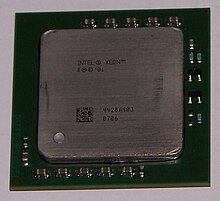Clovertown (microprocessor)
Gallatin
 |
| Produced |
From March 2003 to 2004 |
| Max. CPU clock rate
|
1.5 GHz to 3.2 GHz |
|
FSB speeds |
400 MT/s to 533 MT/s |
| Min. feature size |
130 nm |
| Instruction set |
x86 |
| Microarchitecture |
NetBurst |
| CPUID code |
0F7x |
| Product code |
80537 |
| Cores |
1 |
| L1 cache
|
8 kB + 12 kuOps trace cache |
| L2 cache |
512 kB |
| L3 cache |
1 MB, 2 MB, 4 MB |
| Application |
DP and MP Server |
| Package(s) |
|
| Brand name(s) |
|
Paxville
| Produced |
From October 2005 to August 2008 |
| Max. CPU clock rate
|
2667 MHz to 3000 MHz |
|
FSB speeds |
667 MT/s to 800 MT/s |
| Min. feature size |
90 nm |
| Instruction set |
x86 |
| Microarchitecture |
NetBurst |
| CPUID code |
0F48 |
| Product code |
80551, 80560 |
| Cores |
2 |
| L2 cache |
2×2 MB |
| Application |
DP Server, MP Server |
| Package(s) |
|
| Brand name(s) |
|
Tulsa
| Produced |
From August 2006 to August 2008 |
| Max. CPU clock rate
|
2.5 GHz to 3.5 GHz |
|
FSB speeds |
667 MT/s to 800 MT/s |
| Min. feature size |
65 nm |
| Instruction set |
x86 |
| Microarchitecture |
NetBurst |
| CPUID code |
0F68 |
| Product code |
80550 |
| Cores |
2 |
| L2 cache |
2×1 MB |
| L3 cache |
16 MB |
| Application |
MP Server |
| Package(s) |
|
| Brand name(s) |
|
The Xeon is a brand of x86 microprocessors designed, manufactured, and marketed by Intel Corporation, targeted at the non-consumer workstation, server, and embedded system markets. The primary advantages of the Xeon CPUs, when compared to the majority of Intel's desktop-grade consumer CPUs, are their multi-socket capabilities, higher core counts, larger cache memory, and support for ECC memory. A Xeon Phi co-processor, or co-processors, can be used alongside an existing Intel Xeon processor to provide increased/improved computing power, requiring an available PCI Express 3.0 x16 slot in x16, or x8 mode.
Disadvantages that make Xeon processors unsuitable for most consumer-grade desktop PCs include lower clock rates at the same price point (since servers run more tasks in parallel than desktops, so core counts become more important than clock rates), absence of an integrated GPU, and non-existent support for overclocking. Despite such disadvantages, Xeon processors have always had popularity among desktop users, (primarily gamers, and extreme users) mainly due to higher core count potential, and lower price to performance ratio vs. the Core i7. Because most Intel Xeon CPUs lack an integrated GPU, systems built with such integrated GPU lacking processors require a discrete graphics card if a VDU output is desired.
...
Wikipedia





